Bitcoin and a Lesson in Electricity Markets

In their desperation to find a reason for why bitcoin is terrible-bad-destructive-awful and morally reprehensible, the crypto-obsessed authors of the Financial Times blog Alphaville – Jemima Kelly, Jamie Powell, Izabella Kaminska – are quickly running out of good choices.
Their latest one is the “environmental FUD” – a classic in our world of environmentally obsessed elites, where anything remotely associated with The Climate ensures moral supremacy. If all else fails, guilt-by-association will not. So, complain away about the environmental impact from the energy used by the Bitcoin network’s nodes and miners.
What’s so strange about this objection is that first, that impact is globally small, and second – who cares? Somebody, somewhere, is using energy in ways that you disapprove of (shocking, I know), to which the only reasonable response must be “Yes, and?”
Few free(ish) societies run around policing the use of energy, letting woke Establishment journalists decide on what’s permissible use, what’s harmful, and what needs to go. People drive cars, sometimes just because they want to, and sometimes just to compete to see who’s fastest; people go on vacation, mostly because they want to; people buy stuff, ride stuff, build stuff, enjoy stuff, almost all of which use energy and almost never require permission slips from their morally superior overlords. Not yet at least.
Throwing bitcoin into the mix somehow changes everything. Somebody, somewhere, is running their specialized hardware to validate the network, when they could have used those components (microprocesses, flash memories, fans, storage facilities) to, I don’t know, run a server hall to host all your incredible Instagram pictures. What is it about Bitcoin’s energy requirement that really triggers these people? If you think Bitcoin is a terrible payment mechanism, a subpar currency, a destabilizing base money, or a grand financial fad, those are arguments on their own merits – what’s energy got to do with it?
On a first-pass observation it’s a perfect “gotcha” argument: if you think Bitcoin’s value-add is zero, or negative – Kelly happily calls it “a destructive asset class” – any amount of energy would be a waste, a climate nightmare, an environmental catastrophe. After all, we often hear that this monetary scam consumes electricity on par with small– or medium-sized countries. When the New York Times uses words like “enormous farms” and “endless racks of computers” we know it must be bad.
As usual when journalists talk about Big Terrible Things, we must dig a little deeper and probe a little more: ask those annoying questions – how much? Is that a lot? Compared to what?
Estimates for electricity use by the full Bitcoin network are all over the place, partly because nobody really knows how many miners there are and what exact equipment they’re using (and for environmental concerns, what electricity source powers their facilities). Low estimates hover around 40 TWh per year – a little less than Massachusetts used in 2019 – while high estimates report as much as 100 TWh per year – roughly the electricity generation of South Carolina or Louisiana. Let’s take the worst case and conveniently round number of 100 TWh.
That’s 2.5% of the 4,000 TWh of electricity that was used in America’s record year of 2018, or less than 0.4% of world electricity generation in 2019. Besides, if global electricity use fell by 1% last year because of the pandemic measures, the “savings” could power the entire Bitcoin network’s current use until 2024 (or 2028 at the lower estimate). If Bitcoin had not existed, it’s safe to say that our Alphaville electricity police would have found some other miniscule electricity user to complain about – maybe Christmas lighting (7 TWh), ski resorts (2-5 TWh), or online gaming (75 TWh). Perhaps the global banking system’s ATM networks (at something like 25 TWh)?
Remember that we’re still only on electricity use; the sleight-of-hand involved in the Alphavillers’ magical trick is to equate use with “really bad for the environment.” By this same metric, the electricity generation used to power said writers’ computers qualifies – as does definitely the heating of their apartments (fossil fuels?) and the electricity that brightens their dark homes and runs their home appliances. While minuscule in proportion to thousands and thousands of miners upholding a decentralized monetary network, the Alphaville value add is clearly less than zero and so definitely a horrible waste of electricity.
If you live in a world of averages and aggregates – like Kelly, when she writes that since most mining is in China where “two-thirds of all electricity is generated by coal power” – Bitcoin mining must indeed be dirty.
Bitcoin mining is a cutthroat business, almost entirely determined by local electricity prices (though funding costs and legal risks matter). Thus, bitcoin miners are superbly positioned to seek out and find stranded energy, energy that cannot find its way to market, energy that has no opportunity cost: natural gas that otherwise would have been flared; hydro capacity that would have been flushed; wind turbines that otherwise would have turned off or detached from the grid.
When ARK Invest and Square recently released a report on the renewable energy prospects for bitcoin miners, they offered mining facilities next to stranded energy as a supplement to overcome the intermittency problem. “Intermittency,” snarked Kelly, ridiculing the authors for not understanding that bitcoin consumes electricity without later bringing it back: it’s not the storage mechanism that solves renewable energy’s unsolvable problem.
A brief reminder of the three basic problems of renewables:
- they don’t produce much electricity when we need it: nights, evenings, and in the Northern Hemisphere, winter;
- they produce a lot of electricity when we don’t need it very much: days and summer;
- they produce this electricity geographically far from where we need it: rural plains, offshore, islands.
For each of these problems, what we end up doing in electrical grids with plenty of solar and wind is to:
- Have expensive backup power – mostly natural gas or coal plants – at the ready to start producing electricity when the wind or sun won’t suffice. This is the reason that electricity costs go up – not down – when more renewables are added to the grid.
- When sun and wind power are about to blow out their grids from overproduction, one of two things usually happen: small countries like Denmark can export its electricity to larger neighbors like Germany and Sweden (offloading the problem to someone else) or the renewables just shut off. Last year, wholesale electricity prices even dipped below zero to desperately induce industrial consumers to take the surplus electricity from the producers.
- Our transmission lines are filled to capacity: in the short term, we go back to turning off intermittent sources, and in the long term we crisscross our countryside with more aluminum lines to accommodate trans-Continental sharing of excess electricity.
Institutional Bitcoin proponents like Cathy Wood of ARK Invest or Jack Dorsey, against whom the Alphavillers direct their current environmental FUD, did not imagine these problems. Producers of stranded energy, like the oversized hydro plants in the four Chinese provinces where most mining apparently takes place, cannot bring their goods to market – but they can offset some of their fixed costs by selling it to reliable bitcoin miners. Did Wood, Dorsey, and Brett Winton (research director at ARK) argue the case in a clumsy fashion, implying that bitcoin could help solar energy power the entire electricity grid? Yes. Are they therefore wrong to say that shedding excess electricity to willing miners helps financing renewable (or nonrenewable) electricity generation? Not at all.
On the contrary: Nic Carter, the master of environmental FUD-busting, writes
“[c]ompletely off-grid natural gas is entirely nonrival with household or commercial energy consumption. It was never going to be monetized, captured, consumed, or delivered to households. Its fate was simply to be combusted or vented.”
If some of that excess electricity – of the wrong kind, in the wrong place, at the wrong time – can be used to mine bitcoin and finance the electricity provider’s operations, isn’t that an efficiency improvement? The global crew of bitcoin miners vacuum the unused, stranded, and wasted energy of the world, providing extra dough for the marginal electricity generator whether renewable or not. Sounds good to me.
We should indeed be skeptical of financial fads, of everything in the Everything Bubble. And we should argue over bitcoin’s many monetary attributes – mostly because we therefore highlight how other monetary regimes work. But the environmental accusations of Bitcoin’s mining operations is like hitting your head against brick walls – not a very useful thing to do.
Like the great JP Koning concluded this week, “It’s not the energy needs of these products that is the problem.”











